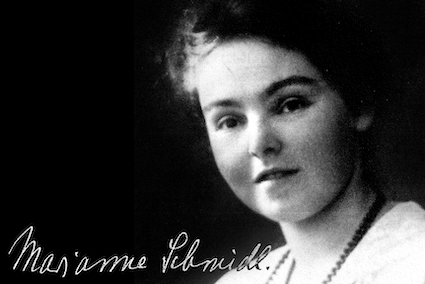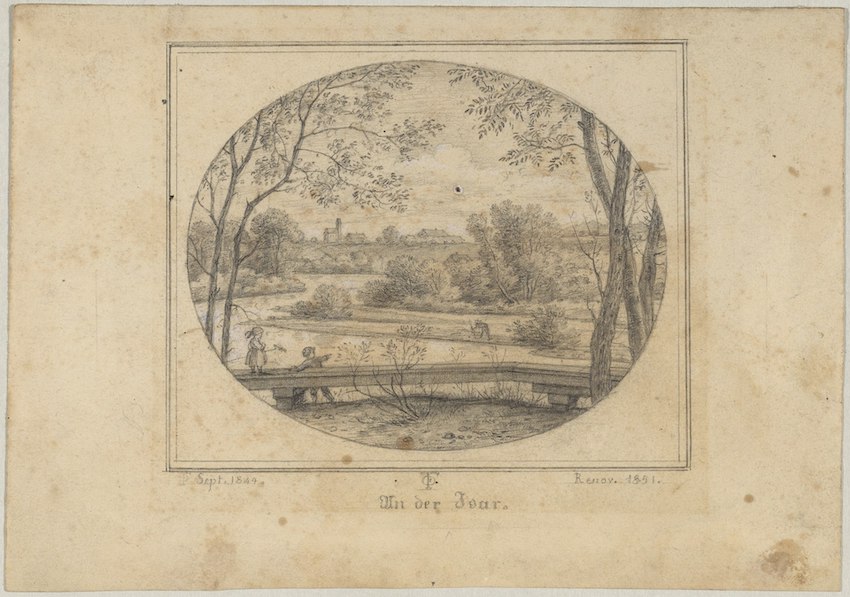マリアンネ・シュミッドル
Marianne Schmidl, 1890-1942

マリアンネ・シュミッドル
Marianne Schmidl, 1890-1942

★マリアンネ・シュミドル(シュミッドル)(1890年8月3日ベルヒテスガーデン -
1942年4月イズミカゲットー)は、ウィーン大学で民族学の博士号を取得した最初の女性[1]。オーストリアの民族学者、教師、司書、美術収集家で、ユ
ダヤ人であることからホロコーストでナチに略奪・殺害された。
| Marianne Schmidl (3
August 1890 in Berchtesgaden – April 1942 in the Izbica Ghetto) was
first woman to graduate with a doctorate in ethnology from the
University of Vienna.[1] An Austrian ethnologist, teacher, librarian
and art collector, Schmidl was plundered and murdered in the Holocaust
by the Nazis because of her Jewish origins. |
マリアンネ・シュミードル(1890年8月3日ベルヒテスガーデン
-
1942年4月イズミカゲットー)は、ウィーン大学で民族学の博士号を取得した最初の女性[1]。オーストリアの民族学者、教師、司書、美術収集家で、ユ
ダヤ人であることからホロコーストでナチに略奪・殺害された。 |
| Family and education Marianne Schmidl's mother, Maria Elisabeth Luise Friedmann (1858–1934), lived in Munich, and worked for the writer Paul Heyse. Schmidl's great-grandfather was the painter Friedrich von Olivier, a close friend of Julius Schnorr von Carolsfeld, and her great-granduncles were the brothers Heinrich Olivier and Ferdinand Olivier, who were also artistically active. Her father, Josef Bernhard Schmidl (1852–1916), of Jewish origin, was a court lawyer from Vienna and a social democrat.[2] Shortly before the marriage on 23 July 1889, which was vehemently rejected by the Friedmann family, he converted to Protestantism. The Jewish background of her father would prove fateful for Schmidl when the Nazis came to power. Marianne was the oldest of two sisters in Berchtesgaden, where the family-owned a holiday home. However, she grew up in Vienna and received the best possible education for girls at the time. From 1905 to 1909 she attended the progressive “Black Forest School” of the pedagogue and salonière Eugenie Schwarzwald. From 1910, Schmidl studied mathematics and theoretical physics at the University of Vienna.[3] In the winter semester of 1913–14, however, she switched to ethnology as a major, anthropology and prehistoric archeology as a minor.[4] Shortly before that she had joined the Association for Austrian Folklore and had worked out a folklore topic for the first time with “Flax growing and flax processing in Umhausen”. Michael Haberlandt and Rudolf Pöch were among her teachers. In 1916 she was the first woman to receive her doctorate.[5][6] |
家族と教育 マリアンネ・シュミードルの母、マリア・エリザベス・ルイゼ・フリードマン(1858-1934)はミュンヘンに住み、作家ポール・ヘイゼのもとで働いて いた。シュミードルの曽祖父は、ユリウス・シュノール・フォン・カロルスフェルドの親友であった画家のフリードリヒ・フォン・オリビエで、曽祖父はハイン リッヒ・オリビエとフェルディナンド・オリビエの兄弟で、彼も芸術家として活躍していた。父親はユダヤ系のヨーゼフ・ベルンハルト・シュミードル (1852-1916)で、ウィーンの法廷弁護士で社会民主主義者だった[2]。1889年7月23日の結婚の直前に、フリードマン家に猛烈に拒絶されて プロテスタントに改宗することになる。この父親のユダヤ人としての経歴は、ナチスが政権を握ったとき、シュミードルにとって運命的なものとなった。 マリアンヌは2人姉妹の長女として、ベルヒテスガーデン(別荘を所有していた一家)に生まれた。しかし、彼女はウィーンで育ち、当時としては最高の女子教 育を受けていた。1905年から1909年まで、教育学者でサロネーゼのオイゲニー・シュヴァルツヴァルトの「黒い森学校」に通う。 1910年からはウィーン大学で数学と理論物理学を学んだが[3]、1913-14年の冬学期には専攻を民族学に、副専攻を人類学と先史時代の考古学に変 えた[4]。その少し前にオーストリア民俗学会に入会し、「ウムハウゼンにおける亜麻栽培と亜麻処理」で初めて民俗学のテーマを扱った。ミヒャエル・ハー バーラントやルドルフ・ペッヒが彼女の教師として名を連ねていた。1916年、彼女は女性として初めて博士号を取得した[5][6]。 |
| Working life Marianne Schmidl first worked at the Berlin Museum of Ethnology. From autumn 1917 she worked under Theodor Koch-Grünberg at the Linden Museum in Stuttgart as an “assistant for African questions”. After a stint at the Grand Ducal Museum for Art and Applied Arts in Weimar, Marianne Schmidl was unable to find an adequate job for a long time. Michael Haberlandt later asked whether “the two characteristics female and Jewish were an obstacle to filling a position within ethnology”. From March 1921 she worked at the Austrian National Library, with a permanent civil servant position from 1924, as a lecturer for anthropology, science, mathematics and medicine. In addition, she continued her scientific research in the field of African cultural history, specializing in particular in basket weaving. From 1926 she worked on a research project on African handicrafts at the Museum für Völkerkunde in Vienna, which was financed by the Saxon Research Institute for Ethnology in Leipzig. In the course of this, she researched ethnographic museums in Switzerland, France, England, Belgium, Germany and Italy and published numerous scholarly works.[7][8] |
社会人生活 マリアンネ・シュミードルは、最初ベルリン民族学博物館に勤務した。1917年秋からシュトゥットガルトのリンデン美術館でテオドール・コッホ=グリュー ンベルクのもとで「アフリカ問題担当助手」として働く。ワイマールの大公国美術・応用美術館に勤務した後、マリアンネ・シュミードルは長い間、適切な仕事 を見つけることができなかった。ミヒャエル・ハーバーラントは後に、「女性でユダヤ人という二つの特徴は、民族学の中で職を得るための障害になるのか」と 質問している。1921年3月からオーストリア国立図書館に勤務し、1924年からは正規の公務員として、人類学、科学、数学、医学の講師を務めた。ま た、アフリカ文化史の分野で科学的な研究を続け、特にバスケット織りを専門としていた。1926年からは、ライプツィヒのザクセン民族学研究所の資金で、 ウィーンの民族学博物館でアフリカの手工芸品に関する研究プロジェクトに取り組んだ。その過程で、スイス、フランス、イギリス、ベルギー、ドイツ、イタリ アの民族誌博物館を調査し、多くの学術的な著作を発表した[7][8]。 |
| Nazi persecution and deportation After Austria's Anschluss or "annexation" to the Nazi German Reich in 1938, Marianne Schmidl was declared Jewish because her father was Jewish, even though she considered herself to be Christian.[9] She was forced out of her job, and thrown into poverty by the special taxes Nazis inflicted on Jews in order to take their property.[10] Schmidl was forced to sell her family's artworks but was unable to flee. In April 1942, she was deported to the Izbica ghetto in Poland and from there presumably to the Belzec or Sobibor concentration camps.[11] Her last sign of life was in May 1942. The circumstances and exact date of her death are unknown, and she was not declared dead until May 1950.[12] |
ナチスによる迫害と強制送還 1938年にオーストリアがナチス・ドイツ帝国に併合された後、マリアンヌ・シュミードルはキリスト教徒であると自認していたが、父親がユダヤ人であった ためユダヤ人と認定された[9]。 仕事を追われ、ナチスがユダヤ人の財産を奪うために行った特別税によって貧困に陥った[10]。1942年4月、彼女はポーランドのイズビツァ・ゲットー に、そこからおそらくベルゼクかソビボルの強制収容所に追放された[11]。 彼女の最後の生存の兆候は1942年5月であった。彼女の死の状況や正確な日付は不明であり、1950年5月まで死亡が確認されなかった[12]。 |
| Art collection and its restitution Marianne Schmidl is remembered today not only as Austria's first Ph.D. in ethnology,[13] but also because – in the course of the principles for the restitution of looted art formulated at the 1998 Washington Conference – she was the original owner of many drawings by the brothers Olivier and Julius Schnorr von Carolsfeld could be made out. After her mother's death in 1934, she inherited the entire family collection of drawings by the Olivier brothers and von Schnorr von Carolsfeld. After the "Anschluss" of Austria in 1938, Schmidl was forced to submit a property declaration on 30 September 1938 for her art collection on which the Nazi imposed special taxes. The special taxes for Jews, the repayment of the funding for their research, and the reduced salary collectively left Maria Schmidl with no choice but to sell the collection of drawings.[14] Her non-Jewish brother-in-law, Karl Wolf, brought the lot to the Viennese dealer Christian Nebehay, who in turn passed them on to the Leipzig action house C. G. Boerner. On 28 April 1939, 19 sheets belonging to Schmidl were auctioned anonymously as “Collection W” (today identified as “Collection Wolf”). The Albertina in Vienna restituted 8 sheets by Friedrich Olivier to the family's heirs in 2013. In 2014, two more drawings by Olivier from the Kupferstichkabinett in Berlin in 2015 two sheets from the Kupferstichkabinett in Dresden were restituted.[15] In 2016 'A Branch with Shriveled Leaves' which had been sold under duress by Schmidl in Austria in 1939, was restituted by the National Gallery of Art.[16] The NGA had acquired the drawing as part of the Wolfgang Ratjen collection.[17] In 2019 a drawing by Friedrich and another by Ferdinand Olivier were restituted from the Lenbachhaus in Munich.[18] |
美術品コレクションとその返還 マリアンネ・シュミードルは、オーストリア初の民族学博士としてだけでなく[13]、1998年のワシントン会議で策定された略奪美術品の返還のための原 則の中で、オリヴィエとユリウス・シュノール・フォン・カロスフェルド兄弟の多くのデッサンの元の所有者であったことが、今日記憶される理由である。 1934年に母親が亡くなった後、彼女はオリヴィエ兄弟とフォン・シュナー・フォン・カロスフェルドのデッサンコレクションをすべて受け継いだ。1938 年にオーストリアが "併合 "されると、シュミードルは1938年9月30日に、ナチスが特別税を課した彼女の美術コレクションについて財産申告書を提出することを余儀なくされた。 ユダヤ人に対する特別税、研究費の返済、給与の減額などが重なり、マリア・シュミードルは画集を売却せざるを得なくなった[14]。 ユダヤ人ではない義兄のカール・ヴォルフがウィーンのディーラー、クリスチャン・ネーベヘイに持ち込み、ネーベヘイはライプツィヒの活動家、C・G・ボルナーに譲渡した[14]。 1939年4月28日、シュミードル所有の19枚が「コレクションW」として匿名でオークションにかけられた(現在は「コレクション・ウルフ」と名付けられている)。 ウィーンのアルベルティーナは2013年にフリードリヒ・オリヴィエの8枚を相続人に返還した。 2014年にはベルリンのクプフェルシュティヒカビネットからさらに2枚、2015年にはドレスデンのクプフェルシュティヒカビネットから2枚のオリヴィエのデッサンが返還された[15]。 2016年、1939年にオーストリアのシュミードルによって強要されて売却された「しなびた葉を持つ枝」が、ナショナル・ギャラリーによって返還された[16]。 NGAはこの素描をヴォルフガング・ラッチェンコレクションの一部として取得していたのである[17]。 2019年にはミュンヘンのレンバッハハウスからフリードリヒの素描とフェルディナンド・オリヴィエの素描が返還された[18]。 |
 |
An der Isar, an 1844 drawing by Friedrich Olivier, restituted by the Lenbachhaus in Munich |
| Publications (selection) 1913 Flachs-Bau und Flachs-Bereitung in Umhausen. In: Zeitschrift für Österreichische Volkskunde. Band 19, 1913, S. 122–125. 1915 Zahl und Zählen in Afrika. In: Mitteilungen der Anthropologischen Gesellschaft in Wien, Band 45, 1915, S. 166–209. This work (her dissertation) was fundamental to a new approach, which considered mathematics as a universal science, independent of culture and society. She stated that there are rather completely different types and expressions of counting and calculating. 1928 Altägyptische Techniken an afrikanischen Spiralwulstkörben. In: Festschrift für Wilhelm Schmidt, (SVD), S. 645–654. 1935 Die Grundlagen der Nilotenkultur. In: Mitteilungen der Anthropologischen Gesellschaft in Wien. Band 65, 1935, S. 86–125. (The last essay she published) 2005 (Posthum) Afrikanische Spiralwulstkörbe. In: Katja Geisenhainer: Maria Schmidl (1890–1942), Leipzig 2005, S. 265–339. |
|
| Aryanization The Holocaust in Austria List of Claims for Restitution for Nazi-looted art Ethnology Jewish women in the Holocaust Gender bias on Wikipedia |
|
| https://en.wikipedia.org/wiki/Marianne_Schmidl |
https://www.deepl.com/ja/translator |
| [Gingrich 2005:119] |
+++
Links
リンク
文献
その他の情報


